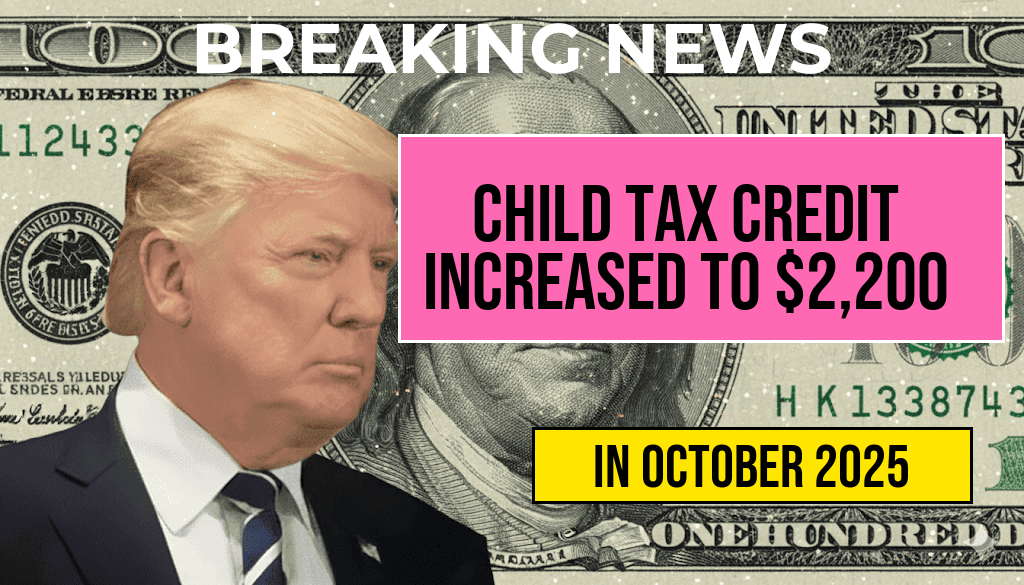The federal government has announced an increase in the Child Tax Credit, boosting the amount families can receive to $2,200 per child. This change aims to provide immediate financial relief to millions of American families, especially those with lower and middle incomes, amid ongoing economic challenges. The adjustment, part of recent legislative efforts, is expected to impact approximately 35 million children nationwide, offering increased support for essential expenses such as housing, education, and healthcare. The new credit amount applies to qualifying children under age 17, with eligibility criteria remaining consistent with previous programs. Experts anticipate that this enhancement could significantly reduce child poverty levels and improve economic stability for vulnerable households. As the policy takes effect, families are encouraged to review their eligibility and update their tax information accordingly to maximize benefits. More details about the program and application process are available on official IRS resources.
Background and Legislative Context
The increase to the Child Tax Credit stems from recent legislative measures aimed at strengthening social safety nets. Historically, the credit has undergone several adjustments since its inception, with notable expansions during the COVID-19 pandemic to support economic recovery. The current enhancement reflects a bipartisan effort to address longstanding disparities and provide targeted assistance to families struggling with rising costs of living. According to the Wikipedia entry on Child Tax Credits, these programs have been a key component of U.S. family support policies for decades, evolving to better target low- and middle-income households.
Details of the New Benefit
| Year | Maximum Credit per Child | Income Limitations |
|---|---|---|
| 2022 | $2,000 | Phase-out begins at $200,000 (single) / $400,000 (married) |
| 2023 (Current Increase) | $2,200 | Same income thresholds as 2022 |
Eligibility Criteria
- Child Age: Under 17 years old at the end of the tax year
- Taxpayer Income: Must meet specified income thresholds to qualify for the full amount
- Residency: Child must reside with the taxpayer for more than half the year
- Tax Filing Status: Available to both individual filers and joint filers
Impact on Families and Broader Economy
Analysts project that the increased Child Tax Credit could lift hundreds of thousands of children out of poverty, according to data from the Center on Budget and Policy Priorities. Families report using the additional funds for essentials such as rent, groceries, and healthcare. For example, a household with two children under 17 could see an increase of nearly $400 annually per child, translating into tangible financial relief. This boost is also expected to stimulate local economies, as families spend the extra income on goods and services, supporting small businesses and employment rates.
Community and Policy Reactions
Advocates for child welfare praise the increase as a critical step toward reducing economic inequality. Forbes highlights that the policy aligns with broader efforts to strengthen family support systems. Critics, however, emphasize the importance of ensuring that eligibility and delivery mechanisms are efficient to prevent delays or misallocation of funds. Policymakers continue to debate the future of such programs, with some proposing permanent enhancements to the Child Tax Credit to sustain long-term benefits.
Next Steps for Eligible Families
Families should review their tax filings and ensure that their information is current with the IRS to receive the increased credit. Many eligible households may automatically qualify based on prior filings, but updates to income or dependents should be reported promptly. The IRS has also expanded digital resources and guidance to assist families in understanding their eligibility and applying for the credit. Additional support programs, including advance payments, are being evaluated to further streamline the distribution process.
Resources and Assistance
- IRS Child Tax Credit Information: irs.gov/child-tax-credit
- Eligibility and Application Guidance: Contact local tax assistance centers or visit the IRS website for detailed instructions
- Community Support: Many nonprofits and community organizations offer free tax preparation services to assist families in claiming their benefits
Frequently Asked Questions
What is the new amount for the Child Tax Credit?
The Child Tax Credit has been increased to $2,200 per eligible child, providing greater financial support to families.
Who is eligible to receive the increased Child Tax Credit?
Eligible families typically include those with children under age 17 who meet certain income requirements, ensuring benefits reach millions of families.
How does the increased Child Tax Credit benefit families?
The increase offers more financial assistance to help cover expenses related to raising children, such as education, healthcare, and daily needs.
When does the increased Child Tax Credit take effect?
The enhanced Child Tax Credit is part of recent legislation and is applicable for the current tax year, providing immediate benefits to qualifying families.
How can families claim the increased Child Tax Credit?
Families can claim the Child Tax Credit when filing their tax returns, and may also qualify for advance payments depending on their circumstances.







